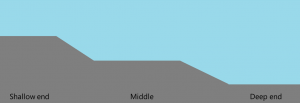As you can likely tell from the title of this post, I am going to go into the detail of what I think is a novel new way to attempt to describe how various states of mental health can and do affect us all differently.
Firstly I think it is important to get across a very simple, but often overlooked point when it comes to mental heath, and that is that mental health is something that we all have, much like the blood in our veins, the air in our lungs or the bacteria in our guts. But much like those 3 critical things, I would be willing to bet that for the mass majority of the population, i.e. above 80% if not 90%, most will not think about these things until there is a problem that is affecting them. The same can be as easily said for mental health.
So this brings me to an important point, why bring this up and why now? Well the story for this post starts back in July 2019, when I was accepted to speak at Microsoft Ignite, Microsoft’s premier conference about all things related to Microsoft technology. That being said however I wasn’t accepted to talk about Microsoft tech (which I could ramble on about for weeks) but more so about Mental Health as you can read more about in https://blog.kilasuit.org/2019/09/02/speaking-at-microsoft-ignite-2019-but-not-about-tech/ & watch my session at http://ignite.mhasl.me & whilst I have been meaning to get back to writing more about Mental Health, this thread about #UnifiedCutleryTheory https://twitter.com/UmbralReaver/status/1233335355572543488 kicked off the inspiration to get this written.
This post will get a little wordy so a sensible length TL:DR would be as simple as this.
The Swimming Pool Analogy is a method that can be used to describe about a person’s current state of Mental Health and how it is affecting them in a way that is simple for others to conceptualise and more importantly be easier to visualise and then enact upon too.
Once 2 people know and understand the Swimming Pool Analogy they can easily share about how their current state of mental health is affecting them to each other using a very simple to use visual representation to each other without converting the current conversation to one that is completely about mental health.
This is particularly useful in a setting where it may not be comfortable or appropriate to discuss, like in public or within a work setting like a meeting, allowing a further conversation about mental health to be brought up at a more appropriate time.
Why A Swimming Pool?
Whilst trying to find a way in which to simplify how to describe how Mental Health can affect each person differently for my presentation at Microsoft Ignite, I went over many a different idea & finally settled on something completely new, the Swimming Pool Analogy.
In general the core goals in coming up with this analogy were to
- Make it simpler to explain that Mental Illness is a part of Mental Health & that it actually isn’t the biggest part to Mental Health.
- Help explain that having a Mental Illness doesn’t label someone as being “stuck” and defined by their illness & that illness is only a small part of the wider “pool” that makes up Mental Health as a whole.
- Help in explaining that anyone can move between differing states of Mental health in any direction, sometimes erratically & violently, other times gradually & slowly.
- Help in explaining that sometimes movements can be helped with external aids, like therapy or medication, or often just requiring time, patience & most importantly a good support network.
- The state of one’s mental health can change due to may different factors, much like the ebb and flow of water in a swimming pool.
And it was that last point that truly made me have the light bulb moment of this really could work as an analogy.
Though I do recognise that all of the above is a lot to try an cover with 1 analogy, I feel that this manages to properly cover all the base principles that this analogy is attempting to cover.
The reason why a Swimming Pool is used for this analogy as I believe that most of us would be able to conceptualise & understand what is meant in a much easier manner as an addition to the already available combination of Spoon/Fork/Knife Theories, particularly as visualising energy isn’t a simple thing and is totally subjective to each person, much like the utilisation of fuel in different cars produces different Miles Per Gallon results.
By this I mean that I expect that we can all visualise what the cross section of a swimming pool with 3 or more depths looks like, much like the below, and how at each of the different depths within the swimming pool it can make dealing with all variances of Mental Health, not just Mental Illnesses, in vastly much more different ways.
As you see above within the pool there is a certain total volume of water, but it is only at different stages in the pool do we start to get concerned or struggle to stay afloat and breathe due to the amount of water that is surrounding us, which I think nicely sums up closely to how we then cope with the current state of our mental health. Its also important to point out at this point the above diagram is highly simplified, and that each of the 3 main parts all have various segments to them from the farthest to the left being the most shallow, to the farthest to the right being the deepest part of the pool.
The Shallow End - aka Mental Wellness
This section of the pool is where I would conceptually say a large proportion of the populace either fall within or would believe they fall within. This part of the swimming pool is where you could say that you are mentally doing well, life seems to be going good and you don’t have above average amounts of worry, upset, fear, anxiety etc, keeping you from managing to go about your day to day lives with relative ease.
In fact for many in this part of the pool they may not even have any inclination about the state of their mental health at all, and may even be entirely oblivious to the fact that they too, like every other person on the planet, have mental health, just like we have physical health. Some in this part of the pool unfortunately can be classified as “Mental Health Deniers”, though many change this view when further states of Mental Health, particularly unwellness & illness start to affect either themselves or their closest loved ones.
But it’s important to say that there are percentile segments of this part of the pool, just like all other parts of the pool. So you may be in the 0-10 percentiles where you could be totally oblivious or you could be in the 90-100 percentile parts where you are more than aware of your mental health and what state it is in but that it isn’t drastically effecting you.
If you want another way to conceptually visualise this, then you could also liken this part of the pool to a nice Sunny, cloudless day.
The Middle - aka Mental Unwellness
This section of the pool is where I would conceptually say that there is a large proportion of the populace falls in and whilst some may be either blissfully unaware or completely aware of, I would expect the mass majority in this part of the pool have some base awareness of their own Mental Health.
This part of the swimming pool is where you could say that whilst you are mentally coping, it isn’t all sunny days and rainbows & that things can be tough. For many in this part of the pool there are can often be a mix of good and bad days, each of these having varying levels of above average amounts of worry, upset, fear, anxiety etc, that can keep those in the pool from managing to go about their day to day lives with ease. This is not to say that for many in this part of the pool it is impossible to do so, however it is most probable that those in this part of the pool may need additional forms of support to do so, whether this be medications, reduction & more flexibility in their working lives, therapies & support groups.
For many in this part of the pool they likely are more than aware about the state of their mental health, they may not understand it fully but they, if they have at least admitted and accepted that something may not be quite right, will at least feel less build up of pressure as to why they feel the way that they feel. I generally find that people that fit into this area of the pool are much more likely to have the capability to empathise and sympathise with others in each of the parts of the pool as they are less likely to be oblivious to the fact that they too, like every other person on the planet, have mental health, just like we have physical health. The phrase “lived experience” is incredibly fitting for those in this part of the pool, which is why you are likely to find a higher proportion of those that have suffered with Mental Illness and have managed to recover into this part of the pool will be working in our health services or in online support groups.
But it’s important to say that there are percentile segments of this part of the pool, just like all other parts of the pool. So you may be in the 0-10 percentiles where you could be still be dealing with your mental health but having a really good day, or you could be in the 90-100 percentile parts & really struggling and be having a really bad day. Either way those in this part of the pool are very much more aware of the state of their mental health and also the states of others around them.
If you want another way to conceptually visualise this, then you could liken this part of the pool as an outcast day filled with various amounts of light or dark clouds.
The Deep End - aka Mental Illness
This section of the pool is where I would say that there is a lower proportion of the populace that falls within this part of the pool. This part of the swimming pool is also where many of the misconceptions about mental health have come from, particularly due to incredibly poor historic reporting, particularly onwards from the 1960’s, on various mental illnesses including, but not limited to, schizophrenia, psychosis, multiple personality disorders, eating disorders & even mood disorders like depression & bi-polar disorder.
One of the reasons why I like the Swimming Pool analogy is that when you think that the Deep End of the pool really can have no end to it’s depths, and therefore could have a theoretical lack of “light at the end of the tunnel” that’s when you start to understand a bit more about the feelings that people that are currently dealing with more suicidal thoughts may be experiencing.
However it’s really important to mention that actually even for those at the deepest and darkest depths with their mental health, whether that be due to suicidal thoughts or being on the deepest and darkest levels, can, if given the right levels of support, whether that be via the means of medical, social, housing, or support in the workplace, find it possible to essentially swim back into less deep parts of the pool and therefore metaphorically “see the light” (I recommend you to google/bing Blues Brothers See the Light) which is all we can hope for with those that are really really struggling and that they can with helping hand support pull themselves back up. I personally believe that we each have the power to lend some much needed support to those that are struggling the most, particularly when mental health services internationally are drastically underfunded.
In fact for many in this part of the pool they may be so bogged down with how they are feeling that they may not even have any inclination about the state of their mental health at all, and may even be entirely oblivious to the fact that they too, like every other person on the planet, have mental health, just like we have physical health. This often isn’t because they are unable to see others suffering but more often than not they are struggling to see themselves in a state where they are not suffering at all.
But it’s important to say that there are percentile segments of this part of the pool, just like all other parts of the pool. So you may be in the 0-10 percentiles where you could be totally oblivious or you could be in the 90-100 percentile parts where you are more than aware of your mental health and what state it is in.
If you want another way to conceptually visualise this, then you could liken this part of the pool to a day with torrential rain fall.
Are we permanently stuck in one part of the Pool?
Absolutely not! In fact, it is more than possible to start in the shallow end, have something in our lives that drags us all the way though to the deepest and darkest parts of the deep end and then for us with enough time & support manage to metaphorically “swim” back into the shallow end once again. Whilst this is less than common, it isn’t an impossibility and I can only hope that those reading that may be in the deeper ends, can see that there can be light at the deepest depths of the pool and that they can, with time, support and most importantly a little bit of self determination, get back into more manageable parts of the pool.
It is also really worth mentioning that your mental health is meant to go through states of ebbs and flows between the various depths throughout our lives. Whether that be the ending of relationships, friendships/colleagues/romantic, or the loss of a job, home or of loved ones through unfortunate deaths, but it is also just as much supposed to ebb and flow to the more shallow areas too, whether that be through attaining a new home/job, completing the simple tasks at home that you may have put off (like the washing up or piles of clothes that need to get washed) or the addition of new life into our lives whether that be gaining new friends, pets, partners, children or other family members.
How can we describe whereabout in the pool we are?
This one is once you understand it fully, incredibly simple to put into practice & more importantly is incredibly quick in sharing what your current state is.
When someone may feel that they are in the shallow end of the pool they would be able to describe it as if the water level is at most up-to their waists like the below image shows (please excuse my poor design skills) & that there is very little pressure on them to be able to allow their mental health to breathe easily whilst they are going about their day to day lives.
To express that you feel like you are in this part of the pool to someone else, you should try to smile & hold your hand to your waist. Whilst that may to many first seem pretty illogical, as we tend to think that when we are in a good place we are high up / on top of the world and many would think that we should hold our hands above our head. However when you think about it form a mindset of “am I able to breathe right now & how deep am I in being unable to breathe” it makes more sense to try to smile & hold your hand to your waist & will make more sense as we go through the rest of the following areas of the pool.
Those in the middle of the pool may feel more “pressure” on their mental health to breathe as easily as those in the shallow end because as the levels of the water in the pool rise, so does the internal panic of being unable to breathe, which can really make living in this part of the pool incredibly tiring. Ask anyone you know that is suffering and just about coping to “keep their heads above water” and I would highly expect that many will tell you that struggling to keep their heads above water is incredibly tiring, and that they may require more periods of downtime, with extended naps, periods where they do very little and need to relax a lot more or may even find that they sleep much much more than usual. They may also find it harder to get up and be fully ready for the day ahead, and as such these are reasonable signs that a loved one is perhaps struggling, even if they do not want to tell you themselves, or even admit it to themselves.
To express that you feel like you are in this part of the pool to someone else, you should try to express some form of low emotion, like a small frown & hold your hand to your neck. This makes the most sense for this part of the pool as many in this part of the pool will be keeping their heads above water, and are either coping ok with it or are struggling with it.
Those in the deep end of the pool are likely to be feeling the most “pressure” on their mental health & may be finding that they are unable to breathe at all. In this part of the pool the internal panic of being unable to breathe is likely at it’s highest, as essentially in this part of the pool it would be equally measured as someone that may be drowning if they were in a Swimming Pool. This can really make living in this part of the pool not just incredibly tiring, just like in the middle part of the pool, but almost unbearable.
To express that you feel like you are in this part of the pool to someone else, you should try to express some form of low emotion, like a small frown & raise your hand above your heard. This makes the most sense for this part of the pool as many in this part of the pool will not be be keeping their heads above water, and are likely really struggling with it.
You can further extend each of these responses with a few additional simple actions.
To show that you want to speak about it - nod your head.
To show that you want to speak about it, but not now - nod your head & place your other hand up, holding all 5 fingers up as if to say stop.
To show that you do not want to speak about it, at least not right now - shake your head.
To show that you do not want to speak about it at all - shake your head & place your other hand up, holding all 5 fingers up as if to say stop.
It is important that we as friends, colleagues, family members and even strangers, respect each person when they give any of the above signals and let them know that if and when they want to talk to us, that we are here to listen to them.
I hope that now you have read this and can take on board how the Swimming Pool Analogy may help you in having discussions with your friends, family, co-workers, and even health professionals have a more open discussion about your mental health, and I hope that you’ll remember It’s #TimeToTalk, But it’s also #TimeToWrite
Please share this post with the following hashtags on Social Media
#SwimmingPoolAnalogy
#MentalHealth
#ItsGoodToTalk
I’m Ryan ( twitter | blog ) a successful IT Consultant & the founder of mhasl and Mental Health Affects Someone Like Me




